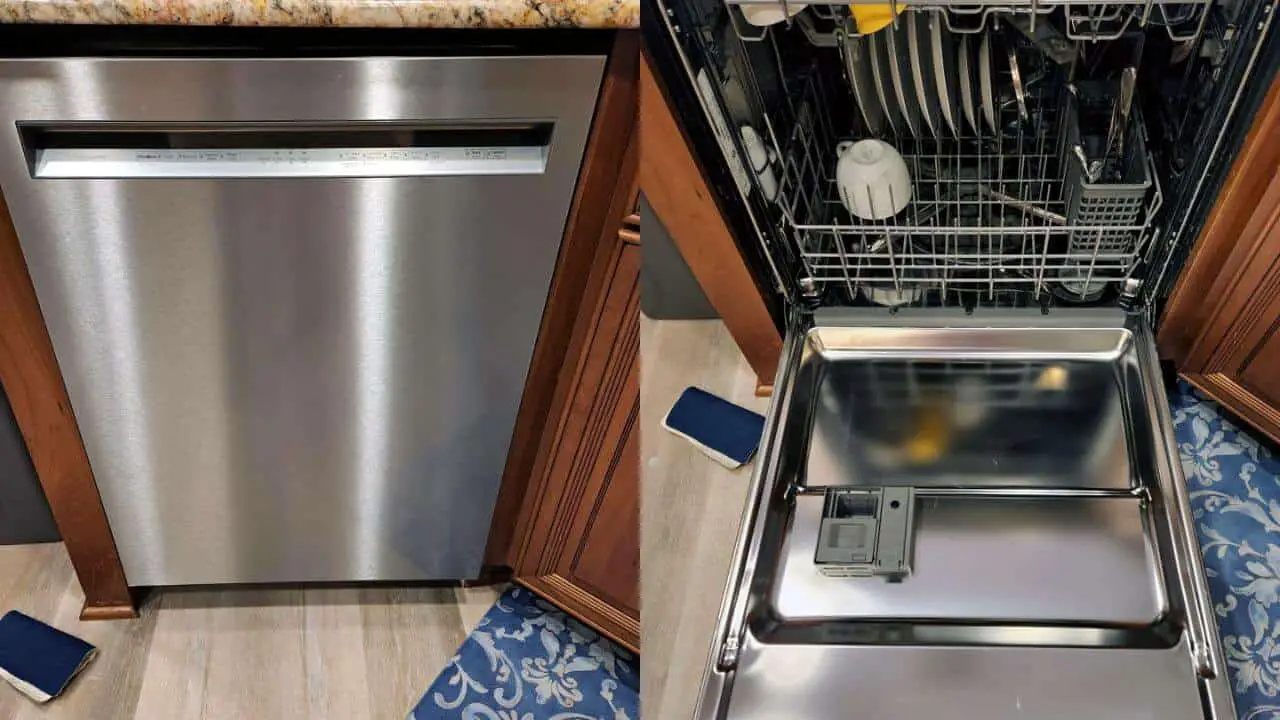Last Updated on August 15, 2023 by River Tree Farms
The wash cycle in a KitchenAid dishwasher should start immediately after the appliance fills with water. The bad news is that, at times, you may notice that your KitchenAid dishwasher fills but does not wash. While this is a rare problem, it can indeed happen, so you need the correct information to help you when that time comes.
The wash cycle of a dishwasher involves the impeller pushing water through the spray arms. Together with the motor and pump, these two are the essential components of the wash cycle. If any of these components malfunctions, the wash cycle will not occur as usual. In this article, we will dive into the real reasons that can cause a dishwasher to fill but fail to wash. We will also explore various ways to fix this issue. Stay tuned.
Why Is My KitchenAid Dishwasher Filling and Draining but Not Washing?
A dishwasher works in the following stages: filling, washing, draining, rinsing, and drying. Each stage should occur smoothly if the dishwasher is in perfect working condition. In other words, if the dishwasher skips a stage, the utensils will likely come out dirty, wet, or both.
The end of a washing cycle prompts the outlet valve to open and let water out through the drain. Once all the dirty water leaves the dishwasher, the inlet valve opens for clean water to rinse the dishes. The solenoid valves control the flow of water in the dishwasher. So, if your dishwasher can fill and drain without hitches, the valves are working perfectly.
If a KitchenAid dishwasher fills but does not wash, you could be staring at any of the following issues: –
A faulty motor
The motor is one of the main components that enable the washing process. It powers the pump, which, in turn, runs the impeller attached to it. If the motor fails, neither the pump nor the impeller will function as expected.
To test the motor, you need to: –
- Turn the dishwasher off and disconnect it from power.
- Locate the motor.
- Unscrew and detach it from the electrical connections.
- Test for continuity by placing each multimeter probe on every terminal.
If the motor is okay, you should get a zero-resistance reading on the multimeter display. If not, you will either notice a high resistance or no reading. Also, place one probe of the multimeter on one terminal of the motor and the other probe on the metal casing of this component. This shouldn’t show any reading if the motor is working perfectly.
Clogged spray arms
The KitchenAid dishwasher has two spray arms, one at the top and the other at the bottom of the racks. These spray arms have tiny holes through which the impeller pushes water.
With time, these holes clog with debris from dirty dishes, blocking water flow from the impeller. So, if your KitchenAid dishwasher fills but does not wash, you could be dealing with something simple as clogged spray arms.
A broken impeller
As mentioned earlier, the impeller is responsible for pushing water at high pressure from the pump, through the spray arms, to the dirty dishes arranged on the racks. It is worth noting that if this part of the dishwasher breaks, the whole wash cycle will not occur. This is because it won’t be able to force water through the spray arms.
Pump malfunction
Powered by the motor, the pump pushes water from the floor of the dishwasher to the impeller. If the pump malfunctions, water will remain at the dishwasher’s base, so the wash cycle will not happen.
Easy Way to Fix KitchenAid Dishwasher Fills but Does Not Wash
Having a dishwasher that fills but won’t clean dishes can be devastating. That’s why you need to diagnose and devise a solution for this problem.
The method you use to fix your KitchenAid dishwasher solely depends on what’s preventing the wash cycle from happening. Here is a look at easy ways to fix a KitchenAid dishwasher that stops working during the wash cycle: –
- Clean the spray arms – If clogged spray arms are causing trouble for your dishwasher, make sure you clean them. Since the spray arm hoses are tiny, use a thin yet firm object such as a wire to pierce through the dirt.
- Replace the motor – If you discover a faulty motor, replace it with a new one. This will not only solve the problem but also prevent similar problems from occurring in the near future. Take note that the motor may be stuck and not necessarily faulty. As such, don’t replace it before looking deeply into the issue.
- Fix the pump – Depending on what problem the pump has, you can either fix or replace it with a new one.
Once you fix the problem, ensure you run a wash cycle to test whether or not the dishwasher is working normally. Remember, while unclogging clogged spray arms is something you can do by yourself, you may want to call for help with more complex steps, such as replacing the motor.
Frequently Asked Questions
How do I clean the spray arms?
To clean the spray arms, first, detach them from the dishwasher and use a thin, straightened wire to unclog the holes. Next, scrub the spray arm using a non-abrasive material and rinse it under running water.
Only use a dishwasher-safe detergent even though you’re washing the spray arms in the sink.
How often should I clean the spray arms?
Spray arms will clog depending on how much dirt has accumulated. While you can always wait for a total clog to clean it, you should consider performing routine cleaning for this part and the filters.
Once every two weeks is okay, although you can adjust this time to what’s favorable for you.
Can a faulty heating element cause the wash cycle to fail?
No. A heating element only raises the temperature of the water to help ease the removal of grease and dirt from utensils. It also heats the dishwasher’s internal to promote moisture loss during the drying cycle.
Therefore, the wash cycle will still run normally with a faulty heating element. Unfortunately, the utensils will likely come out dirty and greasy. Also, the drying cycle will not occur, so your dishes will come out wet.
Read More Posts:
Final Words
The KitchenAid dishwasher fills but does not wash dishes every time a component involved in the wash cycle fails. These components include spray arms, motors, pumps, and impellers. If you notice a problem with your dishwasher, focus on the named components in your diagnosis. It will be easier for you to find the problem and solve it using some of the ways suggested in this article.
Take note that you can always call a professional plumber or home inspector to fix the problem. Doing this will eliminate the room for making mistakes that can cost you a whole new dishwasher.

